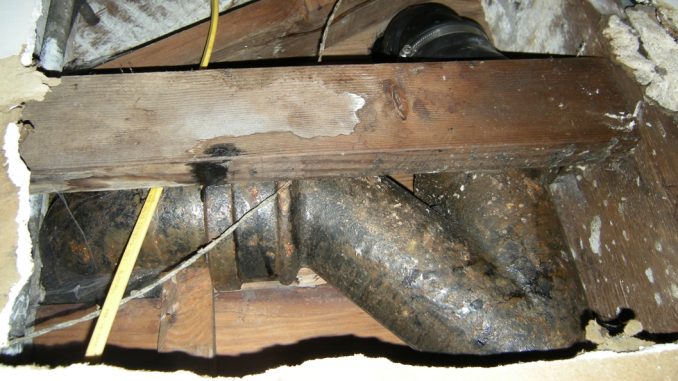
There is something about carrying out a cast iron pipe repair that makes the task seem particularly daunting.
Perhaps it is because most iron pipes that need fixing are connected to the toilet, a device which some people view as being too grim to touch and others as being a necessity far too important to attempt to repair without any specialist knowledge.
Cast iron pipes also look quite terrifying. Whereas a copper pipe appears small and almost friendly and plastic PVC pipework is made of a material we deal with every day, cast iron is cold, strong and menacing. It looks like it should not be messed with.
The good news is that cast iron pipe repair is not nearly as scary as you might expect. In fact, fixing a leaking cast iron pipe can be as straightforward as traditional plastic pipe repair and copper pipe repair.
Here are three simple steps to return your cast iron pipe to working order.
Clean away any corrosion or dirt
When a cast iron pipe fails, it is often due to corrosion on the inside. If you do not know where your pipe is leaking from, looking for patches of rust is often a good way to identify the problem area.
Once you have found the crack or hole then you can prepare the leak area for repair. Cast iron pipes are old and sturdy and that means that they can accumulate a lot of dirt over the years, especially if they are part of a toilet waste system.
You should try and remove dirt and corrosion from the pipe by sanding it down with a piece of sandpaper. Sanding will get rid of dirt, grime and debris. The cleaner the area of cast iron pipe that you want to fix, the easier it will be to repair.
Use a sealing material to plug the hole
Cast iron pipes are often located in difficult positions which can make repairs challenging. If you can gain good access to the pipe, then a self-fusing silicone pipe repair tape is often the best option for sealing the crack.
By stretching a pipe repair tape to up to 300% its length, you can get a tight seal even on leaks up to 30bar pressure where the water cannot be turned off. Once wrapped, the tape will fuse into a solid rubber band over the leak area – it is that easy.
When working in confined spaces such as the back of a toilet, it may not be possible to get the required stretch needed to ensure the pipe repair tape bonds effectively – in which case, you should instead use an epoxy putty like Superfast Steel Stick.
Superfast Steel is a two-part putty in a pre-prepared stick format with activator and base. You simply cut off the required amount of epoxy putty from the stick and knead it by hand.
As the epoxy putty completes mixing, the two contrasting colours will blend into a cast iron colour. You then apply the epoxy putty by pushing it into the hole or crack in the pipe. Within 10 minutes, the putty will harden, sealing the pipe.
Overwrap the repair with a pipe repair bandage
To ensure that the repair is permanent, the sealing material can be overwrapped with a pipe repair bandage which provides a rock-hard, impact resistant layer.
Pipe repair bandages are water-activated. You simply dip the bandage in water, the resin will react and you then wrap the pipe, smoothing the bandage down as you go. It will set within 30 minutes and the cast iron pipe can be put back into service an hour after the repair is completed.
All the products needed to fix a leaking toilet waste pipe are available in a SylWrap Universal Pipe Repair Kit. Pipe Repair Kits sell for less than £20, a far cry from the average cost that a plumber in the United Kingdom charges.
Fixing a troublesome cast iron pipe yourself is a cost-effective means of repair – and it is nowhere near as daunting as you might have first thought.

My toilet is leaking when flushed I can feel the water on the piece of cast iron pipe connected to the loo, I cant see where its leaking from, iv wrapped towel and plastic around it to soak it up, it appears to been leaking a while as the skirting board behind the toilet is soaked and the plaster has absorbed the water a foot over the skirting board, I never noticed water on the floor I think it may have gone down the hole where the main water pipe is behind the loo.
So how do I find the leak and can tape do the job or do I need to replace the pipe?
Hi Mary. One of our technicians will be in contact with you via email about how to find your leak and then hopefully repair it.